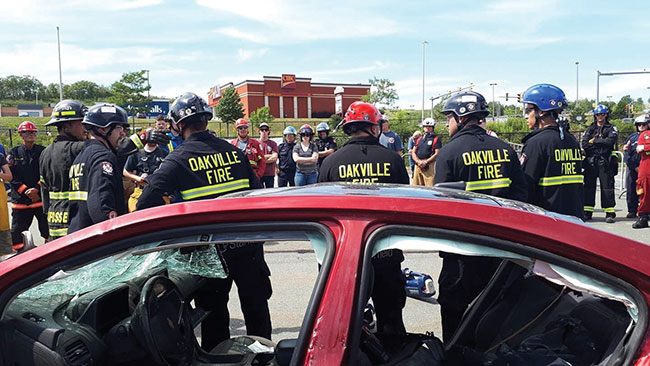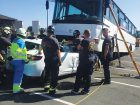
Extrication tips: How to build a training program
By Chad Roberts
Features Auto Extrication Chad Roberts editors pick Here is a group of us training with Jason Defosse. Reaching out to tool manufacturers like Code 4 Fire & Rescue can benefit your auto-ex program. Photo: Chad roberts
Here is a group of us training with Jason Defosse. Reaching out to tool manufacturers like Code 4 Fire & Rescue can benefit your auto-ex program. Photo: Chad roberts In my last article, we addressed some common cutting issues when it comes to new technology. This edition, I’d like to stick with common issues, but also address a broader subject in regards to training standardization and where to start. I’ve been approached too often by members of other departments, and some in my own, about where to start with an auto extrication training program. It’s way too easy and common nowadays to get a beat-up old car, a couple tools and a crew together and just start wrecking away. Cars generally aren’t free, time is money and hands on the tools is a limited experience for everyone at best. We owe it to ourselves to approach each one of these opportunities with a plan. And by plan, I mean something that is catered to each specific situation. We have to consider operator experience, tools available and even the type of vehicles and situations that are common in our jurisdictions. To simplify this, I’m going to break down the common skills needed on an awareness, operations, and technician level. Just like any other tech rescue, auto extrication should be approached by referring to correlating NFPA standards to ensure we are addressing our training situations properly and safely.
Let’s start with our awareness level. The first place we need to look to is not the tools, but rather to our departments’ standard operating procedures. If you don’t have one, reach out. Lots of departments across the country have very detailed SOPs that will help guide the first-in crews at these scenes. From there, we need to keep our heads in the books and start looking at simple vehicle technology, glass types, and patient access options. Once there is a basic knowledge established, we can start getting our hands dirty. Simple cribbing procedures such as chalking the wheels, vehicle stabilization and shutdown procedures should all be addressed before we start up the tools. Tool recognition and familiarization is also a huge area to touch on. Let’s not get focused on the very simple choice options of hydraulics. Make sure you identify all options your department has when it comes to cutting, pushing, and displacing metal. Being able to identify simple hazards, patient access points and tool deployment according to your specific SOPs are all very important parts of the awareness level and should never be overlooked, or the entire foundation of your program will be lost.
Okay, time to start up the tools, operations level. The place to start here is not on YouTube learning the newest and most complex options. We need to start with simplicity. Think box cribbing and glass removal. Single door removal, roof removal and dash pushes with our rams are all that should be addressed in our operations level. The amount of time and frequency that we have with major incidents is too small to think bigger than these techniques. Proper door removal from the latch side or the hinges is an art and shouldn’t be treated with any less significance. Roof removal requires plenty of hazard identification and coordination that make this an operational level difficulty. Don’t think too big — we will get there.
Now onto our technician level, which I would venture to say is our most broad area of all three levels. I say this because the sky is the limit with auto extrication. Complex tool work and vehicle technology are constantly changing, hand in hand, on a yearly basis and that makes the technician level very fluid. Start with more complex maneuvers, such as total sidewall removals, dash lifts/displacements, and even trunk tunneling. From there, move into situations with vehicles on their sides, roofs and even on top or underneath other vehicles. Throw in common hazards such as trees, hydro poles and jersey barriers to complicate these set ups. And, let’s not forget about readdressing and furthering our knowledge in basic concepts like cribbing. Technician levels should address strut work if your department has them. What about lifting? Now is the time to get out any hydro struts, air bags and jacks that you may have in your arsenal and pair that with proper box cribbing. Lifting is a skill that cannot be overlooked. These operations generally are the most dangerous we will perform in training and on the road, so proper tool selection, load capture and coordination are paramount to address this technician level skill.
Don’t ever settle. Now that you’ve practiced, and maybe even mastered these areas, there is so much more out there. We haven’t even touched on large vehicle heavy rescue, industrial or even agricultural operations. Get your department members through the basics, and don’t stop moving forward.
So, where do you start? Like I mentioned earlier, reach out. There are many different departments across North America that post their SOPs and sometimes their training operations. Reach out to your tool suppliers. These companies often have very knowledgeable staff that are willing to come out show you the newest tools and teach some basic techniques along the way.
The big takeaway is start with a plan. Respect the tools, the technology and most of all your time and safety. By having a plan that is laid out similar to all our other disciplines in the fire service, you will be on the right track to not only address what levels your department is currently at, but where you are going in the future.
Chad Roberts is a firefighter in Oakville, Ont. He is a member of the Oakville extrication team and competes and trains across North America. Contact Chad at chadroberts12@gmail.com.
Print this page

